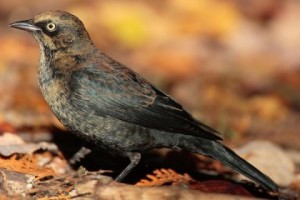This is the fifth in a series of posts on birds at risk in Canada. The Committee on the Status of Endangered Wildlife in Canada (COSEWIC) lists 73 bird species as endangered, threatened or of special concern.

Male rusty blackbird in breeding plumage. Listed as a species of Special Concern in Canada.
It seems inconceivable that a member of the blackbird family could be listed on any conservation list. After all, some of the most noticeable and numerous birds on the continent are red-winged blackbirds, grackles and brown-headed cowbirds – all members of the Blackbird family.
But the rusty blackbird is different. While the Canadian population is estimated to be between 110,400 and 1.4 million, their population has declined a whopping 85 percent since the mid-1960’s.
The COSEWIC status reports states:
Reason for Designation: More than 70% of the breeding range of the species is in Canada’s boreal forest. The species has experienced a severe decline that appears to be ongoing, albeit at a slower rate. There is no evidence to suggest that this trend will be reversed. Known threats occur primarily on their winter range, and include wetland loss, urban development and blackbird control programs in the United States. Designated Special Concern in April 2006.
Rusty blackbirds breed north to the treeline, further north than any other member of the blackbird family. They eat mostly invertebrates during the breeding season, taken by probing in mud and vegetation. Their arboreal nests are often re-used by other species such as Solitary Sandpipers.
The breeding habitat of these birds consists of forest wetlands, such as the streams, peat bogs, marshes, swamps and beaver ponds of the boreal forest. In winter, they are found primarily in damp woodlands and cultivated fields of the mid to eastern United States and southern Canada.
During the winter and on migration, they join mixed-species roosts and feeding flocks. Unlike other blackbirds, this species is seldom a nuisance depredating crops. But that doesn’t save them from bird control programs in the southeastern United States that have occurred since the 1970’s. Other voracious members of their family such as red-winged blackbirds, grackles and cowbirds descend on crops in the millions of birds, and the rusty blackbird is caught in the middle.
The rusty blackbird is considered a species for which Canada has a major responsibility in terms of conservation, as our boreal forest is home to approximately 70 percent of the global breeding population. They are on the Audubon Watch List, and listed as Vulnerable by the World Conservation Union.
It is my understanding that when a wild species is put on a conservation watch list, measures are undertaken to ensure the species does not slip further towards extinction. I am at a loss to explain this further information from COSEWIC.
For North America as a whole, the rusty blackbird is considered apparently secure. The rusty blackbird has no protection in Canada under the Migratory Birds Convention Act (1994). Blackbirds are considered pests in Canada and the United States, and so the rusty blackbird can be killed during control programs for nuisance birds.
How can anyone justify conservation programs for the rusty blackbird when it’s apparently well within the law to poison thousands of them as ‘nuisance’ birds? Or conversely, when it is legal to poison thousands of them, what on earth are they doing on any endangered species list, no matter what the classification?
Birds of America states that because of their remote breeding habitat, inconspicuous behaviour, and lack of economic impact, rusty blackbirds have received little study, and their population status and trends remain poorly known. If there is a way to ensure these birds do not slip closer to extinction, I’m afraid I can’t see it.



Pingback: Rusty Blackbird Sightings Feb - Mar 2010 | Rusty Blackbird